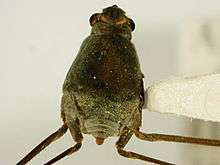Halobates
| Halobates | |
|---|---|
 | |
| Halobates keyanus | |
| Scientific classification | |
| Kingdom: | Animalia |
| Phylum: | Arthropoda |
| Class: | Insecta |
| Order: | Hemiptera |
| Suborder: | Heteroptera |
| Infraorder: | Gerromorpha |
| Family: | Gerridae |
| Genus: | Halobates Eschscholtz, 1822 |
Halobates or sea skaters are a genus with over 40 species of water striders. While many are coastal, about five of these are able to survive and stand on the surface of the open ocean, a habitat containing very few insect species. They are predators, coastal species feeding mainly on fallen terrestrial insects while the oceanic species feed on plankton. The coastal species lay their eggs on rocks near the shore, the oceanic species attach their egg masses on floating objects such as cuttlebone, feathers and plastic waste.[1] Species are found around the world, commonly near the equator.[2] Most are tiny, the body length being about half a centimeter but with long legs of up to 2 centimeters. They are wingless and the abdomen is short and compressed compared to the length of the thorax. Gravid females may appear to have an elongated abdomen.
They were first collected by Johann Friedrich von Eschscholtz, a doctor who was part of a Russian expedition aboard the Rurik between 1815 and 1818.[3][4]
Some species of storm petrel actively feed on Halobates, sometimes splashing the water with their feet to attract or detect sea striders.[5]
The five pelagic species of Halobates are H. micans, H. germanus, H. sericeus, H. splendens and H. sobrinus of which the last four are found only in the Pacific Ocean. The only species with a wide distribution is Halobates micans, which is found in the Indian and Atlantic Oceans.[6]
A fossil species H. ruffoi is known from 45-million-year-old deposits in Verona, Italy.[7]
Close relatives of the genus include Austrobates and Asclepios.[8]
References
- ↑ Big rise in North Pacific plastic waste BBC
- ↑ Marine Insects. Halobates Life. Retrieved on 9-09-2009.
- ↑ Andersen NM; L Cheng (2004). "The marine insect Halobates (Heteroptera: Gerridae): Biology, adaptations, distribution, and phylogeny". Oceanography and Marine Biology: An Annual Review. 42: 119–180.
- ↑ Herring, Jon L (1961). "The genus Halobates (Hemiptera: Gerridae)" (PDF). Pacific Insects. 3 (2-3): 223–305.
- ↑ Cheng, L.; Spear, L.B.; Ainley, D.G. (2010). "Importance of marine insects (Heteroptera: Gerridae, Halobates spp.) as prey of eastern tropical Pacific seabirds" (PDF). Marine Ornithology. 38: 91–95.
- ↑ Cheng, L. (1975). Insecta Hemiptera: Heteroptera, Gerridae, Genus Halobates. Fich. Ident. Zooplancton 147 (PDF).
- ↑ Møller, AN; A Farma; A Minelli; G Piccoli (1994). "A fossil Halobates from the Mediterranean and the origin of sea skaters (Hemiptera, Gerridae)". Zoological Journal of the Linnean Society. 112 (4): 479–489. doi:10.1111/j.1096-3642.1994.tb00332.x.
- ↑ Andersen, N.; Foster, W.A. (1992). "Sea skaters of India, Sri Lanka, and the Maldives, with a new species and a revised key to Indian Ocean species of Halobates and Asclepios (Hemiptera, Gerridae)". Journal of Natural History. 26 (3): 533–553. doi:10.1080/00222939200770341.